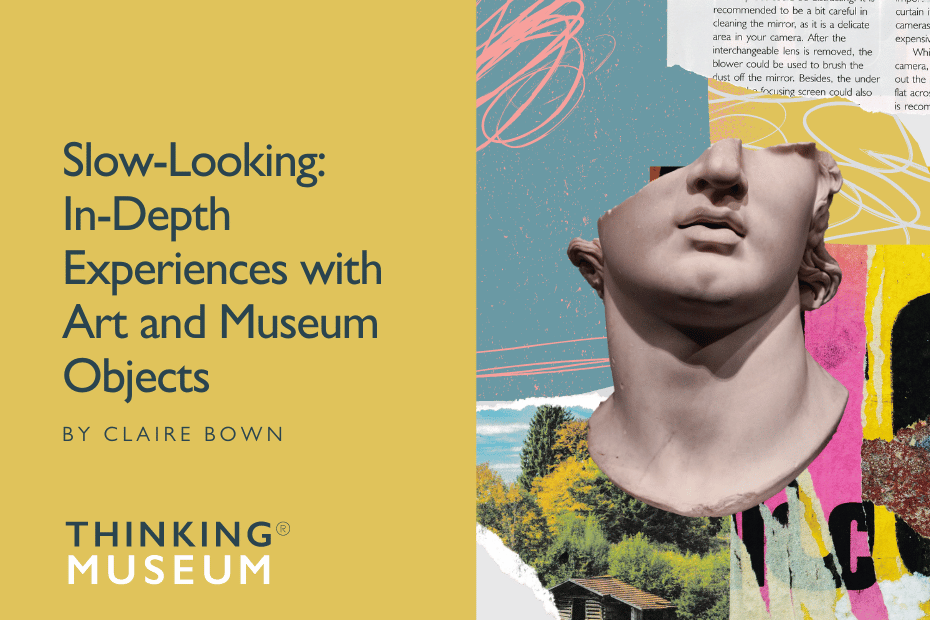Much has been written about the power of art works, objects, artefacts to inspire, provoke curiosity and interest. It is generally accepted that looking at objects stimulates critical thinking through comparing and contrasting, identifying and classifying, describing and summarising and so on. Indeed, museums are increasingly using objects and art to help individuals learn what is variously called slow-looking, close-looking or viewing-skills.
How Long Does the Average Visitor Spend Looking at an Object or Artwork?
Looking is central to the museum experience. When we enter a museum, we are presented with a huge array of objects for us to look at and understand. But does good observation take place? How long does the average visitor spend looking at an object or art work? When I ask this question in my workshops, the answers generally vary from 5 – 30 seconds. There have been many, mainly inconclusive surveys on the subject too – the Louvre found that people looked at the Mona Lisa for an average of 15 seconds, whilst a survey at the Metropolitan Museum of Art found that people looked for an average of 32.5 seconds each. Towards the lower end of the scale, another survey found that viewers were looking at paintings for 2 seconds before glancing at the label for 10.
Certainly in my own, largely unscientific, observations in museums I have noticed that the natural tendency is to have a quick look, make a quick interpretation or judgement (either in your head or vocally), look at the wall text for further clarification and then move on. That’s not in itself a bad thing. But what are missing with our quick glances and hurried observations?
In our fast-paced society, maybe we have lost the skill of observation. We scan, we skim and we scroll. We have forgotten what it’s like to really look at something.
I first got interested in slow looking whilst developing a new educational programme for primary school children at the Tropenmuseum in Amsterdam in 2011. I started using thinking routines (from Visible Thinking, an approach to teaching and learning from Harvard’s Project Zero) and noticed how they gave students the structure to look at objects carefully and slowly, whilst investigating and constructing meaning. With this method, we had participants as young as six looking intently at objects and art in the museum for 15-20 minutes at a time – a real case of the more you look, the more you see.
Looking at something slowly and carefully is in itself a rewarding process – the object or art work becomes more interesting the longer you look at it. Some paintings, for example, do not inspire any sense of connection until you have looked them and thought about them for a while. It’s all too easy to brush off an artwork with ‘I just don’t get it’ but if you ask yourself to stay a little longer, look a little harder whilst thinking about all the questions you have about it; you might ultimately get more out of the experience.
I love working in this way with all age groups – challenging adults to spend an hour in the museum with just 1 or paintings (it can be done!) or timing a group of teenagers to see how long they can spend discussing Barnett Newman’s ‘Cathedra’ in the Stedelijk Museum, and I firmly believe that given the opportunity to slow down, people have a more in-depth experience within the museum itself. However, I am aware that many people find it difficult to spend time looking without a strategy or someone to guide you through the process.
Rewarding & Beneficial
I am not alone in thinking that slow-looking is rewarding and beneficial. Peter Clothier runs one hour/one painting sessions and has written a book on the subject. James Elkins has written about how long it takes to look at a Mondriaan. And Phil Terry started Slow Art Day after spending hours at The Jewish Museum viewing only 2 paintings (Hans Hoffman’s Fantasia and Pollock’s Convergence). The next time you visit a museum, don’t try to see everything. Instead, find a select few pieces to focus on. By taking your time and considering fewer artworks, you will see much more.
Time is very important in the museum environment. By slowing down and viewing fewer objects in a more controlled and careful way, less really is more. The slow exploration of objects allows visitors to become absorbed, to scrutinise and investigate and to find out and construct meaning.
Happy slow looking!
Sign up for my Curated newsletter
Every other Friday I share a small dose of curated inspiration. It might be things I’ve read, things I’ve listened to or things I’ve watched.
Hear about my latest podcast episode and read useful tips, recommendations and things that I love. Join via the button below.
